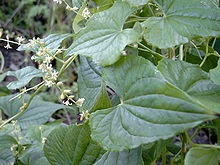Dioscorea communis
| Black bryony | |
|---|---|
 |
|
| Scientific classification | |
| Kingdom: | Plantae |
| Clade: | Angiosperms |
| Clade: | Monocots |
| Order: | Dioscoreales |
| Family: | Dioscoreaceae |
| Genus: | Dioscorea |
| Species: | D. communis |
| Binomial name | |
|
Dioscorea communis (L.) Caddick & Wilkin |
|
| Synonyms | |
|
|
Dioscorea communis (sometimes placed in the segregate genus Tamus) is a species of flowering plant in the yam family Dioscoreaceae and is commonly known as black bryony, lady's-seal, and black bindweed.
It is a climbing herbaceous plant growing to 2–4 m tall, with stems that twine clockwise. The leaves are spirally arranged, heart-shaped, up to 10 cm long and 8 cm broad, with a petiole up to 5 cm long. It is dioecious, with separate male and female plants. The flowers are individually inconspicuous, greenish-yellow, 3–6 mm diameter, with six petals; the male flowers produced in slender 5–10 cm racemes, the female flowers in shorter clusters. The fruit is a bright red berry, 1 cm diameter. Its fairly large tuber is, like the rest of the plant, poisonous.
Dioscorea communis is a native spontaneous species widespread throughout southern and central Europe, northwest Africa and western Asia, from Ireland to the Canary Islands, east to Iran and Crimea.
Dioscorea communis is a typical plant of the forest understory, from the sea to the mountains, usually in dense woods, but it can also be found in meadows and hedges.
According to secondary sources, all components of the black bryony plant, including the tubers, are poisonous due to saponin content. Therefore, it is not typically used internally; however, it has been used as a poultice for bruises and inflamed joints. It has been suggested that black bryony be used topically with caution, due to a tendency for the plant to cause painful blisters.
...
Wikipedia
